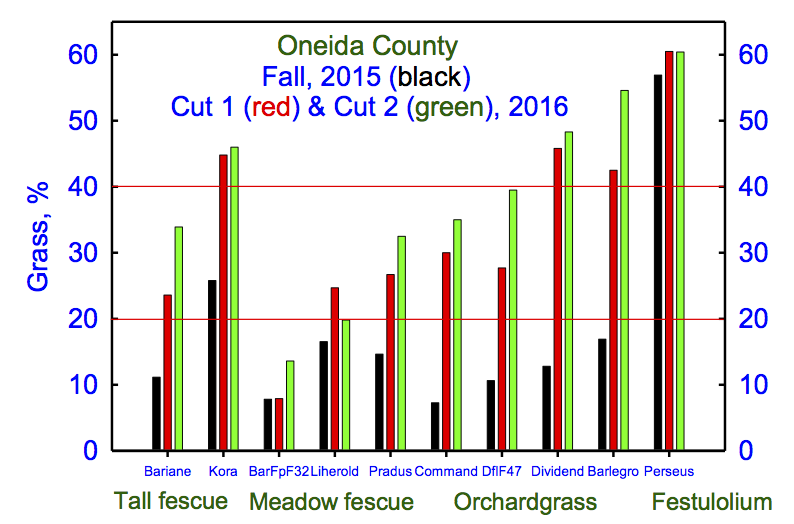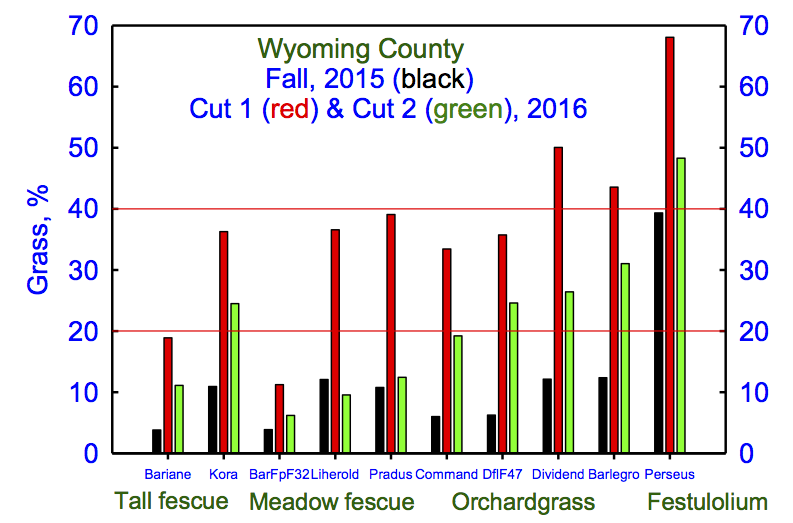J.H. Cherney, D.J.R. Cherney, and K.M. Paddock, Cornell University
Meadow fescue is grown extensively in Canada and Europe, but dropped out of use in the USA decades ago primarily due to reduced yield and disease susceptibility, compared to other grasses. Primarily grown for pasture use, meadow fescue has considerable potential in mixture with alfalfa. Alfalfa-grass mixtures are as high or higher yielding than pure alfalfa, and have been shown to be an excellent forage for lactating dairy cattle.
High Digestibility
Meadow fescue has higher fiber digestibility (NDFD) than most other grasses, consistently 2-4 percentage units higher than tall fescue. Feeding trials across the USA have shown that a one percentage unit increase in NDFD increases milk production by 0.5 to 1.0 lbs/cow/day, and more than 1.0 lb/cow/day for the highest producing cows. Meadow fescue in combination with new reduced-lignin alfalfa varieties can produce a very high quality forage for lactating dairy cows. A somewhat reduced yield potential for meadow fescue may actually be advantageous for alfalfa-grass mixtures, where a grass percentage of < 40% is desirable.
Adaptation and Establishment
Meadow fescue prefers deep, rich soils, and while surviving in wet soils, it cannot tolerate flooding. It will survive under dry conditions but is more sensitive to drought than many other grasses. It can be grown in areas suitable for timothy, and is considerably more winter hardy than tall fescue in northern environments.
Meadow fescue is closely related to both tall fescue and ryegrasses, and a number of hybrids have been developed using various mixtures of meadow fescue, tall fescue, and annual and perennial ryegrass (festuloliums). Festuloliums vary widely in appearance, winter hardiness, and forage quality, due to the relative proportions of fescue and ryegrass in the hybrid.
In mixture with alfalfa, meadow fescue should be seeded at 4-5 lbs/acre in either the spring as early as possible, or late summer about 4-5 weeks prior to first freeze. Meadow fescue often contains a naturally occurring endophytic fungus, but unlike the tall fescue endophyte, no harmful alkaloids are produced. Meadow fescue cannot be infected by the tall fescue endophytes, so there are no concerns of livestock disorders with meadow fescue.
Current Trials in NY
We established seedings of 10 grasses (meadow fescue, tall fescue, orchardgrass and festulolium varieties) in binary mixtures with 2 alfalfa varieties in spring 2015 in Oneida and Wyoming Counties. We thank Dave Curtin/Curtin Dairy and Dave Russell/Southview Farms for providing study sites.
Optimum rainfall throughout the 2015 season resulted in abundant growth, and three seeding-year harvests were taken at both sites. Optimum rainfall also benefited grasses over alfalfa. Although all grasses were seeded at the same number of pure live seeds/square foot, the seeding rate was clearly too high for this particular festulolium (Fig. 1). ‘Perseus’ is a ryegrass-type of festulolium, with rapid, aggressive growth. Our seeding year goal is at least 10%, but no more than 20% grass, in a mixed stand at the end of the seeding year.

Spring of 2016 was abnormal, with cold, dry weather. This had much more impact on alfalfa development than grasses, which flower in response to day length. The cold spring weather resulted in immature, very low fiber alfalfa forage under 30% neutral detergent fiber (NDF) and a little over 30% crude protein (CP) when harvested the last week of May, while NDF of grasses was generally optimum in the low 50’s.
Meadow fescue headed out between May 26 and June 1, 2016, depending on variety and location. Tall fescue and festulolium had a similar heading date range, while orchardgrass varieties headed a few days earlier. About half of the grass varieties were at an early heading stage at spring harvest. Between 20 and 40% grass is desired for years after the seeding year.
Both sites have fertile soils and, in spite of the weather conditions the first two harvests of 2016, averaged a total of 4 tons dry matter/acre. With somewhat adequate rainfall at the Oneida County site, grass% was stable or increasing (Fig. 2). Less rainfall on a soil with less water-holding capacity resulted in a large decrease in grass% from Cut 1 to Cut 2 in Wyoming County (Fig. 3). The relative ranking of grass% among varieties was generally consistent over locations, but environmental conditions significantly impact all grasses. One exception was meadow fescue, which was more negatively impacted by drought than other grasses (Fig. 3).
For spring harvest 2016, alfalfa averaged 57% fiber digestibility (NDFD48h) over both sites, much higher than normal. Grass fiber digestibility averaged a little over 80%. Perseus festulolium was 85% NDFD over sites, not different from the high digestibility selection BARFpF32 meadow fescue (selected from ‘Hidden Valley’) which was 84% NDFD. All other varieties were significantly lower in NDFD. The other two meadow fescue varieties were similar and averaged 80.5% NDFD. Tall fescue and orchardgrass entries were under 80% NDFD.



As the grass% increases in a mixed stand, there is less nitrogen available to grass from alfalfa, and also more grass requiring the limited available N. As the high CP alfalfa% decreases, grass CP greatly decreases (Fig. 4), and total mixed forage CP decreases.
Seed Availability
There has been a meadow fescue seed shortage in the USA the past couple of years. Meadow fescue originally came from Europe, with over 50 varieties in Europe, and the number of varieties available in the USA is rapidly increasing. There are at least a dozen varieties now available in the USA, as well as mixtures of different varieties, and a number of “variety-not-stated” seed sources. Since varieties originate from a wide geographical range and differ in forage quality, it is best to pick a certified, named variety. Mixtures of meadow fescue varieties or variety-not-stated seed may contain completely different varieties next year, even when purchased from the same seed company.
Conclusions
Grass% in mixed stands will be strongly influenced by environmental conditions. Ryegrass-type festulolium is vigorous and aggressive, requiring considerably less seed per square foot than other grasses. Optimum grass growing conditions through 2015 and the early spring of 2016 resulted in very large increases in grass% for most varieties, while prolonged dry conditions at one site greatly reduced grass% at second harvest in 2016. The high digestibility BARFpF32 meadow fescue has not become a significant component of the mixture, while other grasses exceeded the optimum proportion in the mix. Further studies are warranted using high quality meadow fescue and festuloliums in mixture with reduced-lignin alfalfa types to determine best management practices.

